Mount Kilimanjaro is the highest. Kilimanjaro Climbing Routes
Hans Meyer (first to summit Kilimanjaro, in 1887).
Kilimanjaro is a huge dormant volcano with two distinct peaks. The higher one is the peak of Kibo, an almost regular cone with powerful glaciation. The height of Kibo is 5895 m. Despite the fact that the peak is quite high, any healthy person without any mountaineering skills can climb the mountain. The second peak of the mountain, Mawenzi, is slightly lower, 5149 m. But it is technically difficult and accessible only to trained groups of climbers.
If you look down from the top of Kilimanjaro, you can see 7 well-defined trails stretching like ribbons towards the mountain. Five of these trails are climb-only (meaning you can only walk up them, but walking down them from the summit is prohibited by Kilimanjaro National Park regulations). Another trail is for descent only and is called Mweka. And another trail serves both for ascent and descent. It's called Marangu or Coca-Cola way. At an altitude of approximately 4000 m around Kilimanjaro, or rather its main peak Kibo, there is a circular trail connecting all the paths. It is called the Kibo Ring, although it is often divided into two halves - the Northern Kibo Ring and the Southern Kibo Ring. More detailed description See below for these paths.
Climbing routes to Kilimanjaro
There are six main climbing routes leading to the base of Kibo Peak. Listing from the westernmost and further clockwise:
Little used Shira route,
Lemosho Route,
Machame Route,
Umbwe Route,
Marangu route, or Coca-Cola route (Marangu) and
Northern route Rongai or Loitokitok (Loitokitok or Rongai).
Each of these six routes eventually meets the trail that circles the base of Kibo. This loop trail is called the North Rim on the north side and the South Rim on the south. Three trails from the loop lead to the Kibo Peak crater caldera: the Western Gap Trail (also known as the Glacier Arrow Trail), the Barafu Trail, and an unnamed third trail leading from Kibo Hut to Gilmand Point (the lowest point of the caldera from which you can peer into the crater Kibo), we'll call this trail the Kibo Hut Trail.
Kilimanjaro is a huge dormant volcano with two distinct peaks. The higher one is the peak of Kibo, an almost regular cone with powerful glaciation. The height of Kibo is 5895 m. Despite the fact that the peak is quite high, any healthy person without any mountaineering skills can climb the mountain. The second peak of the mountain, Mawenzi, is slightly lower, 5149 m. But it is technically difficult and accessible only to trained groups of climbers.
Which route you take to assault Kibo largely depends on your initial route choice. If you want to climb the more challenging and challenging Glacier Arrow Trail, you will need to start on the Shiva, Lemosho, Mashame and Umbwe routes. If you prefer to storm the peaks at more the easy way Kibo Huts, then you should take the Marangu (Coca Cola) or Rongai route. Of course, you can deviate from this rule, but to do this you will have to obtain permission in advance from the park administration (KINAPA). At the same time, additional costs, bureaucracy and headaches will be provided to you!
Brief descriptions of each of the six routes
Marangu route or Coca-Cola route (5-6 days). This route usually takes no more than 5-6 days and is the oldest and traditionally the most popular. It is closest to the route taken by Hans Meyer, who made the first successful ascent of Kilimanjaro in 1887. It is the only route that does not require tent camp(camping). There are three mountain lodges on it: Mandara hut (2700 m), Horombo hut (3700) and Kibo hut (4700). Despite the fact that most climbers, due to the high cost of staying in Kilimanjaro National Park, strive to conquer Kibo in five days, we strongly recommend 1 additional day in the Horombo hut for proper acclimatization.
Route Machame (6-7 days). The Mashame route is becoming increasingly popular and now rivals the Marangu route. Although most climbers rate it as more difficult than Marangou, more climbers successfully reach the summit via the Machame route thanks to the one extra day, resulting in better acclimatization. Climbing this route, you can storm the summit via the Western Gap, although this shortens the hike by one to two days.
Rongai route (5-6 days). This is the only route starting from the north side of Kilimanjaro. It starts almost from the Kenyan border. This route is very interesting and little used, as a result of which you can see many different African animals, including even elephants. Now this route has shifted somewhat to the east, and now it begins in the town of Loitokitok. Therefore, it received the second name Loitokitok. This route connects with the Kibo Hut Trail just below Hans Meyer's Cave (at about 5000 m) and the assault continues along this trail. Although the trek can be completed within 4-5 days, usually climbers take an extra day to acclimatize and set up camp below Mawenzi Peak.
Umbwe route (5-6 days). The Umbwe route is considered the most difficult route to climb Kilimanjaro. From the very beginning it passes through steep slopes covered with dense jungle, where tree roots serve as steps. Having reached the Southern Rim, climbers continue their assault on the summit, usually through the Western Gap. It is also possible to storm the summit from the Northern Ring along the Barafu trail. Typically this route takes 5 or better yet 6 days. If you come from the Western Breach, the camp is set up in the Kibo Crater. And if you take the Barafu trail, there is a place to camp there called Barafu Campground.
Lemosho route Shira Plateau route (5-8 days). Both of these routes cross the Shira plateau from west to east and compete with the Rongai route in unpopularity, as they are also considered very difficult, especially at the initial stage. The Shira Plateau route is actually very interesting, although it is very rarely used nowadays. The trailhead can only be reached by four-wheel drive truck or jeep. In this case, by car you can get quite high, above the forest zone. Usually climbers begin the walking part from the heather groves area. After crossing the plateau, there are two options for ascent - from the South Rim through the Western Gap or from the North Rim along the Barafu trail. This route usually takes 5-6 days, although if you take a couple of extra days with acclimatization in the Karanga Valley, the probability of a successful ascent becomes much higher.
Lemosho route (5-7 days ) This new route changes Lemosho's route to better side. It starts much lower than Lemosho and gives travelers the opportunity to walk in the tropical rain forest and undergo proper acclimatization. Like the Shira Plateau route, the Lemosho route leads to the top of Kibo via the Western Gap or the Barafu Trail. It usually takes from 5 to 7 days. In the latter case, stops are made at Shira Hut and Karanga Valley.
Descent from Kilimanjaro . In an attempt to regulate the number of people on each route, the Kilimanjaro National Park Authority (KINAPA) has introduced certain rules that govern the descent routes of Mount Kilimanjaro. In general, the main rule is that those ascending from the south or southwest (i.e. the Mashame, Umbwe, Lemosho and Shira routes) should descend along the Mweka trail. And if you ascended the mountain from the southeast or north (i.e. via the Marangu or Rongai/Loitokitok route), you must descend via the Marangu route. Those trekkers who wish to deviate from these rules must first obtain permission from KINAPA.
Seasons and climate on Kilimanjaro
Kilimanjaro is enough big system in order to have your own local climate. The theory of this phenomenon is essentially very simple. The strong winds of the Indian Ocean, blowing from west to east, collide with such a large object as Mount Kilimanjaro. Winds lift moist air masses along the slopes of the mountain, resulting in a drop in temperature and atmospheric pressure, which in turn leads to precipitation - rain at the bottom and snow at the top.
Kilimanjaro has two seasons associated with monsoon winds. One of them is the long tropical rainy season. It lasts from the beginning of March to the end of May. The southeast wind, bringing tropical rains, collides with south side Mount Kilimanjaro, as a result of which it is more hydrated and fertile.
The long tropical rainy season is followed by a short, relatively dry season. Dry winds, the so-called “anti-trade winds,” blow from the northeast from early May until October. These winds squeeze out the southeast monsoons, resulting in rainfall at this time only on the southern side of Kilimanjaro below 3000 m. Therefore, usually the first day of the Marangu, Umbwe and Mashame route is under a canopy of clouds, while the second day is sunny and good weather.
The second rainy season, the so-called short tropical rainy season, usually begins in early November and lasts until February. It is a consequence of the northeast monsoon that prevails at this time. Despite the fact that rain is typical for this time, it is still much weaker than spring, since northeast winds lose their strength and moisture in the dry areas of the African continent. At this time, rain on Kilimanjaro falls mainly below 3000 m.
This theory seems wonderful, but a natural question arises - how did such powerful glaciation and so much snow form on Kilimanjaro if the rains do not rise above 3000 m? The answer is not obvious, but has a good rationale. The anti-trade winds blowing across the saddle (between the peaks of Kibo and Mawenzi) sometimes become so strong that they rise to the very top. At this time it is very windy at the top. Huge banks of clouds sweep over the mountain, causing heavy snowfalls.
That, at least, is the theory behind Kilimanjaro's climate. But in practice, a mountain is rarely so predictable. If you're heading to Kilimanjaro, be prepared for rain as well as good weather.
Despite the rainy seasons, Kilimanjaro can be climbed at any time of the year. The rainy season also provides certain advantages. At this time, in the Ngorongoro, Serengeti, Manyara parks you can see much more African animals than in the dry season. And the mountain, despite the rain, will always give you a chance to climb it and take wonderful photographs.
What is the best time to climb Kilimanjaro?
There are two main seasons for climbing Kilimanjaro, which coincide with the two dry seasons of the mountain's microclimate (these are determined approximately, as even during the dry season bad weather can occur), these are the period from early January to mid-March and the period from June to October. Of course, climbing is possible all year round, although if you go to the mountain during the tropical rainy season, there is a chance that the climb from Kibo hut onwards will be under thick cloud. Many agencies generally suspend activities between November and December, considering climbing at this time to be quite reckless. It is curious, however, during Christmas and on New Year The weather on Kilimanjaro is not at all beautiful, but these periods are the peak in popularity.
The differences between dry seasons are small, although significant. The time period between January and March is colder, as a result of which there will definitely be snow on the route during the assault. The days during this period are clear with very good visibility, making it possible to take wonderful photographs from the top. In addition, during this period the number of people on the routes is significantly less than during the dry season from June to October, which coincides with the main sabbatical holiday in Europe.
It must be said that the second dry season still has cloudiness that does not rise above the tree line. And although during this period there is a high probability of getting wet in the rain, passing the first day from the gate national park Kilimanjaro to Mandara hut, above the forest line the air becomes exceptionally clear.
Also on Kilimanjaro there are clearly 2 tropical rainy seasons - the first lasts from mid-March to early June, the second - from late October to mid-December. As already mentioned, at this time there is a high probability of getting caught in the rain not only below in the zone tropical forest, but also at an altitude of more than 4000 m. In addition, if you go during this period, there is a high probability of storming the summit in thick clouds. However, the summit usually takes place at night, and by dawn the clouds often clear to reveal a stunningly beautiful starry sky. At this time, when it begins to get light, you can capture incredibly beautiful pictures of the surrounding panorama of the second main peak of Kilimanjaro, Mawenzi Peak, rising like an island in an ocean of clouds. Visibility at dawn is exceptionally clear, but changes before our eyes. The dynamics of this process are very fast, like in an accelerated movie. The clouds rise up, filling the vast space and, before your eyes, Mawenzi Peak disappears. This spectacle can only be seen during the tropical rainy season. It must be said that night ascent occurs at negative temperature at any time. But during the period of tropical rains with dawn, the temperature on the mountain rises sharply, sometimes reaching 20 degrees. During dry seasons, severe frost and wind are guaranteed at the top.
So the conclusion is simple - you can go to Kilimanjaro at any time of the year.
Do you need training to climb Kilimanjaro?
Climbing Kilimanjaro does not require any special physical, much less technical, preparation. Some companies and guides insist on the need for preliminary training. And although such training will not hinder you, it is not necessary for climbing the mountain. The main reason for a failed assault is not a lack of physical strength or will of the participant, but the manifestation of symptoms of mountain sickness.
Of course, physical training can be helpful before climbing. For example, you can go to the forest on weekends and walk a dozen or so kilometers. Such activities are unlikely to change your physical fitness, but at least they will give you confidence that you can walk, physically loading your body, for a long time.
If you are unsure of your physical fitness, you can start long weekend walks a month before the ascent, wearing the clothes and, very importantly, the shoes that you plan to wear for the upcoming assault. It is also useful to carry a backpack on your shoulders during the climb.
Another important detail is that when you decide to climb, you probably intend to take Diamox (used for rapid acclimatization). Be sure to check your reaction to this drug before climbing. Then you will be sure that it does not have any harmful side effects on your body.
Who can participate in climbing Kilimanjaro
Kilimanjaro is, of course, a tall mountain. Its height is 5895 m, almost six thousand meters. But at the same time, it is located practically on the equator, where the thickness of the atmospheric layer is much thicker than, for example, in the Caucasus or the Alps. Because of this, the atmospheric pressure at the top is higher than, for example, on Elbrus, which is lower than Kilimanjaro. Also, the location of the mountain on the equator creates its own microclimate, which is much milder than in ordinary mountains.
So climbing Kilimanjaro is a serious challenge, but accessible to anyone.
! The youngest climber on Kilimanjaro . There are rumors about a 7-year-old boy who conquered Kilimanjaro, although this information is unconfirmed. However, according to a South African newspaper report, Joshua Shumaker, a resident South Africa, climbed the mountain in 2002 at the age of 9! This boy not only broke all climbing records, but also violated the main rule of the park - it is allowed to climb the mountain from the age of 10.
! The oldest climber on Kilimanjaro. It is curious that the Guinness Book of Records lists American Karl Hopt as the oldest climber on Kilimanjaro. At 79 years old, he reached the summit in 2004. And although his age must be respected, he is not the record holder. The oldest person to actually reach the top is the Frenchman Valte Daniel. He reached the summit as an 87-year-old man. It can be assumed that Mr Daniel's expedition could not be verified according to the instructions satisfying the Guinness Book. However, for now the Frenchman is the actual record holder. But Karl Hopt needs to wait a little, and when he is over 87, repeat the climb...
Kilimanjaro- the highest and potentially active stratovolcano in Africa, located in northeastern Tanzania, highest point continent (5895 m above sea level). This is the highest mountain range outside the Central Asian belt. From 1902 to 1918 it was called Kaiser Wilhelm Peak(German) Kaiser-Wilhelm-Spitze). Kilimanjaro rises above the Masai plateau, which is located at an altitude of 900 meters above sea level. There are several versions about the origin of the name. In 2003, scientists concluded that molten lava lies just 400 meters below the crater of Kibo's main peak. While no activity other than the current gas emissions is predicted, there are concerns that the volcano could collapse, leading to a major eruption similar to Mount St. Helens. Several landslides and ground shifts have already occurred on Kibo in the past. As a result of one of them, the so-called “western gap” was formed.
Kilimanjaro has no documented eruptions, but local legends speak of volcanic activity 150-200 years ago. The highest point of the mountain and Africa is the Uhuru peak of the Kibo volcano, 5895 m, belonging to the “Seven Summits”. The peak was first conquered by Hans Meyer in the city. The other two peaks are also extinct volcanoes: Mawenzi (5149 m, the third highest peak in Africa after Uhuru and Mount Kenya) and Shira (3962 m).
Encyclopedic YouTube
1 / 1
Arsen Ryabukha: Climbing Kilimanjaro
Subtitles
Story
The first mention of these snow-capped mountains dates back to the 2nd century AD. e. They are indicated on geographical map Ptolemy. But the date of discovery of Kilimanjaro is considered to be May 11, 1848, and the discoverer is the German pastor Johannes Rebman. In 1861, a height of 2500 m was conquered, in 1862 the mark of 4200 m was reached, in 1883, 1884 and 1887 - the mark of 5270 m; all these ascents were made by the Hungarian Count Samuel Teleki. On October 5, 1889, the German traveler Hans Meyer, together with the Austrian climber Ludwig Purtscheller, reached the summit for the first time. In 1996, their fellow climber from the Chaga people, Mzee Lauvo (Lawo), who was supposed to be more than 120 years old, was still alive in Marangu. Mawenzi was only conquered in 1912 by Ohler and Klute.
In the book “Life, travel and work in east africa" you can find a description of how its author, Charles New, attempted to conquer Kilimanjaro in 1861 in tropical shorts and a light shirt, while his 13 porters were completely naked. It is not surprising that they were unable to reach the summit, although they reached the snow line.
origin of name
The name comes from the Swahili language and supposedly means "mountain that sparkles."
It is not known exactly how the name Kilimanjaro came about; there are several theories on this matter. Many of these theories suggest that the word is broken down into Kilima(Swahili for "hill, small mountain") and Njaro, whose versions vary from ancient word Swahili white or sparkling to the word of the Kichagga language (English) jaro, meaning caravan. The disadvantage of these theories is that they cannot explain why the diminutive is used kilima instead of what is appropriate for a mountain mlima. Another approach suggests that the name comes from a Kichagga word kilemanjaare or kilemajyaro, meaning “one who defeats a bird/leopard/caravan.” However, this theory does not explain the fact that the name Kilimanjaro itself was not used in the Kichagga language until recently.
Mountaineering
Climbing Uhuru Peak (5895m, Kibo Volcano) is considered quite simple, but requires time for altitude acclimatization. The main routes leading to it - Lemosho, Machame, Umbwe, Marangu and Rongai - can be climbed by almost any healthy person, without mountaineering training and special equipment. Although it follows from general statistics that only about 60% of all who wish to reach the summit, this is mainly due to: unscrupulous work of local fly-by-night travel companies, chronic health problems, or the body’s too strong reaction to extreme acclimatization. Of the most popular routes, the Marangu Trail has the worst statistics, as it is the only route that can be used for a five-day climb, which for many is a rather difficult challenge. There is another more difficult route with worse statistics, this is the “Western Fault” (Western Breach), but it is of interest only to professional climbers.
Climbing the Mawenzi volcano requires mountaineering training and this moment prohibited due to high risk to life. For the most part, this ban was made due to the influence of the media on tourist flow to Tanzania. Provocative headlines such as “Death on Kilimanjaro” create a negative image among readers of the mountain range as a whole, blurring the boundaries between professional mountaineering and trekking.
They practice speed climbing on Kilimanjaro. The absolute record for total speed ascent and descent of Kilimanjaro was updated on August 13, 2014: 33-year-old Karl Egloff, a Swiss-Ecuadorian mountain guide, ran the Umbwe route through the West Gap, Uhuru Peak (5895 m) and down to Mweka Gate in 6 hours, 56 minutes and 24 seconds. Before this, on September 28, 2010, the Catalan athlete Kilian Jorne Burgada (English) Russian set a world record for ascent in 5 hours 23 minutes and 50 seconds along the Umbwe route, and this record has remained unbroken. Including the descent, its run took 7 hours 14 minutes. Previously, the ascent record belonged to Kazakhstani citizen Andrei Puchinin - in 2009 in 5 hours 24 minutes 40 seconds along the Marangu route.
Geography
Location
Kilimanjaro rises in northeastern Tanzania to 5,891.8 meters as measured in 2008 using GPS and gravimetry, replacing the previous value of 5,895 meters obtained in 1952 by a British team. The height, which has been the subject of measurements since 1889, with results that differed by more than a hundred meters, is the largest in Africa and therefore Kilimanjaro is one of the Seven Summits. It is located near the border with Kenya, which runs along the northern and eastern slopes of the mountain. It rises in the middle of a flat savannah that surrounds the teardrop-shaped mountain at 4,800 - 5,200 meters, making it the highest isolated mountain in the world. Kilimanjaro covers an area of 388,500 hectares. The mountain with an oval-shaped volcanic cone extends 70 km from northwest to southeast and 50 kilometers from northeast to southwest and is located 340 km south of the equator. Mount Meru is located 75 kilometers to the southwest, and Mount Kenya, the second highest peak in Africa, is 300 kilometers to the north. The nearest town, Moshi, is located south of the mountain in Tanzania, and is the main starting point for climbing it. international Airport Kilimanjaro, located fifty kilometers southwest of the summit, has served the entire region with all its parks since 1971. Dodoma, the capital of Tanzania, and Dar es Salaam are respectively 380 km to the southwest and 450 km to the southeast, while Nairobi is only 200 km to the north-northwest. Coast Indian Ocean- 270 km from Mt. Administratively, Kilimanjaro is located in the Kilimanjaro region, partially covering the areas of Hai, Moshi Rural and Rombo, where the highest point is located, and most of mountains. The volcano is fully included in National Park Kilimanjaro.
Topography
Kilimanjaro is an almost conical stratovolcano. It consists of three main peaks, which are also extinct volcanoes: Shira in the west with an altitude of 3,962 m, Kibo with an altitude of 5,891.8 m in the center and Mawenzi with an altitude of 5,149 m in the east. Kibo is crowned at the top by an elliptical caldera 2.4 km wide and 3.6 km long, surrounding a crater called Reusch Crater with a diameter of 900 meters, in the center of which stands a cone of ash 200 meters in diameter, which called Ash Pit. The main peak, located on the southern edge of the crater, is called Ugur. Other famous points of Kibo are the Inner Cone at an altitude of 5835 meters, Hans Meyer Point, Gilman's Point, Leopard Point and Johann's Gulch. Yohanas "Notch", named after the guide who accompanied the first ascent of the mountain. To the southwest of the peak, about 100,000 years ago, a great shift created the Western Breach, rising on the Barranco Valley Mawenzi, sometimes considered the third highest peak in Africa after Mount Kenya, has been heavily eroded and now has the appearance of a dam that separates from the peaks of Hans Meier, Purtscheller Peak, South Peak and Nordeckle. English Nordecke) From their base several clefts go into east direction, in particular Greater and Lesser Barranco (English: Great Barranco, Lesser Barranco). The Saddle is a plateau with an area of 3600 hectares between Mawenzi and Kibo. The shire from which Johnsell Point is separated consists of half a fractured crater, of which only the southern and western edge. To the northeast of it, at 6,200 hectares, the mountain has the shape of a plateau. About 250 smaller cones lie on either side of these three peaks on a northwest/southeast axis.
Hydrology
Kilimanjaro's ice cap is limited to the peak of Kibo. In 2003 it covered the territory with total area 2 km². It consists of the Furtwängler glacier in the upper part, the Drygalski, Great Penck, Little Penck, Pengalski and Lörtscher Notch glaciers. Lörtscher Notch) and Credner on the Northern Icefield, Barranco Glaciers (or Little Breach, Big Breach), Strela Arrow) and Uhlig in the west, glaciers Balletto, Diamond, Heim, Kersten, Decken, Rebman (English Rebmann) and Ratzel (English Ratzel) on the southern icefield (English Southern Icefield) and, finally, the eastern icefield (English Eastern Icefield). Geographic variability in precipitation and sunshine explains the differences in size between different ice fields.
This cap was once clearly visible, but is now in the process of rapidly melting. It covered an area of 12.1 km² in 1912, 6.7 km² in 1953, 4.2 km² in 1976 and 3.3 km² in 1996. During the twentieth century, it lost 82% of its area. It lost an average of 17 meters in thickness between 1962 and 2000. It is becoming increasingly rarefied and should completely disappear by 2020, according to experts and NASA paleoclimatologists Lonnie Thompson, a professor at Ohio University, or by 2040, according to calculations by a scientific group from the Austrian University of Innsbruck, or by 2050 according to calculations California Academy of Sciences. Ice on some slopes may remain for several additional years due to differences in local conditions. climatic conditions.
Mount Kilimanjaro's cap has been shrinking since about 1850 due to a natural decrease in rainfall of 150 mm, but this trend accelerated significantly in the 20th century. Like the current one, the rapid and almost complete melting of the glacier on Kilimanjaro occurred 4000 years ago during a long 300-year drought. Thus, the average daily temperature has increased by 3°C during the last thirty years at Lyamungu, 1230 m on the southern slope. However, temperatures remain consistently below 0°C at altitudes where glaciers are found. Georg Kaser of the University of Innsbruck and Philipp Mothe of the University of Washington have shown that the sharp shrinkage of the glacier is mainly due to a decrease in precipitation. This may be due to local changes caused by deforestation, which leads to lower vegetation density and lower atmospheric humidity. There is a pattern between the decline in ice cover and the rate of forest loss, especially during the early twentieth century and during the stabilization process. However, as evidenced by the characteristic sharp shape of the ice, the ice is sublimated by solar radiation after several wet decades in the nineteenth century. This is likely accelerated by a slight decrease in albedo in the 20th century, especially in the 1920s and 1930s. Another phenomenon that causes glaciers to shrink is the absorption of heat by dark volcanic rocks and its distribution at the base of the glaciers. They melt, become unstable and break down, increasing the surface area exposed to solar radiation.
Flows from melting ice feed the two major rivers in the area, but 90% of the precipitation is retained by the forest. The disappearance of glaciers should not directly affect the local hydrological regime, unlike deforestation and human activities resulting from the quadrupling of water withdrawals for irrigation over the past forty years. Kilimanjaro forests receive 1.6 million cubic meters of water per year, 5% of which is in the form of precipitation. Two-thirds return to the atmosphere through evaporation. The forest plays a triple role as a reservoir: it retains water in the soil, in biomass and in the air. Since 1976, rainfall has decreased by an average of twenty million cubic meters per year, which is the volume of the current cap in three years, and 25% less in the last thirty years, equivalent to the annual consumption of drinking water by a million Jaggas.
Current state
Although Kilimanjaro does not show strong volcanic activity, the volcano has recently attracted the attention of many researchers. It occupies an area of 97 by 64 km.
In ancient times, the tribes who lived at the foot of Kilimanjaro had never seen snow, so they were convinced that the top of the volcano was covered with silver. But they did not dare to test this hypothesis for quite a long time, since there was a connection with the mountain. great amount myths telling of demons who lived above, guarding treasures.
One day, the local leader made up his mind and sent several warriors on reconnaissance. When they reached the top, they immediately grabbed the silver in their hands, and it melted. And then the aborigines, feeling the cold of the silvery cap of the volcano, called it “The Abode of the God of Cold” and began to use this name no less often than the previous one - “Kilimanjaro” or “Sparkling Mountain”.
The Kilimanjaro volcano is so huge that its height is 5899 m, its length is 97 km, and its width is 64 km. The African continent is located at a slight distance from the main East African ridge, which stretches from east to west through the northern part of Tanzania. Kilimanjaro is located right on the border between this country and Kenya, and you can find it on the map using the following geographical coordinates Latitude 3° 4’ 32″ (3° 4’ 54) south and longitude 37° 21’ 11″ (37° 21’ 19) east.
Although the active volcanic activity of Kilimanjaro is not officially documented anywhere, there is information that the last strong eruption occurred quite recently - about two centuries ago. Currently, the mountain is considered, although an active, but inactive volcano, which can become active at any moment. At the top, emissions of sulfur and greenhouse gases have recently been recorded, and studies have shown that the lava is located some four hundred meters from earth's surface, under Uhuru Peak.
What Kilimanjaro looks like
The highest mountain in Africa was formed more than a million years ago due to excessively active volcanic activity and has quite characteristic contours: its gentle slopes rise to an elongated flat top. It consists of three separate volcanoes, which once united into one.
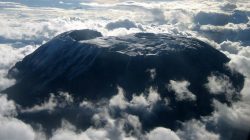
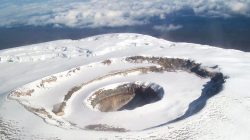
![]()

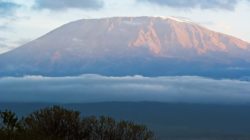
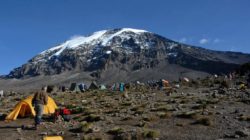
![]()
Shira
The oldest volcano, Shira, is located on the western side, and at the foot there is a fairly flat plateau with an area of 6.2 hectares. Nowadays, the height of Shira is 3810 meters above, while in earlier times it was much higher and was destroyed during a strong eruption.
Mawenzi
It is located on the eastern side and currently represents a peak whose height is 5334 m. From the west, Mawenzi ends abruptly with a whole complex of rocks and gorges, and the height of the volcano on the eastern side is a little more than a kilometer.
Deep radial valleys can be seen at the base of the mountain. And between it and Kibo is the largest high-mountain treeless zone of the African continent - the huge Sedlo plateau, the area of which exceeds 3.5 thousand hectares.
Kibo
Kibo, the youngest volcano (it is considered active and the most dangerous of the three), was formed during several extremely strong eruptions in a row, resulting in the size of its caldera being 2.4 km wide and 3.6 km long. After some time, during the next volcanic activity, first one volcanic cone with a crater 900 m in diameter appeared inside the basin, then an ash cone with a diameter of 200 meters formed in the middle of this crater.
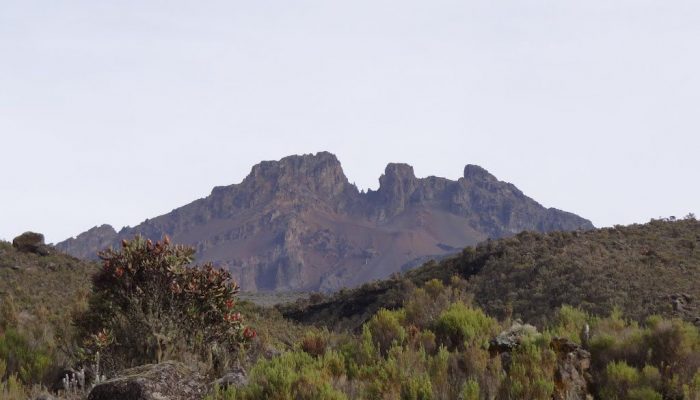
Over time, the Kibo caldera formed a flat, snowy peak on Kilimanjaro (even though, according to the coordinates of the mountain, it is located only a few degrees south of the equator). Snow can be seen not only on the top of the mountain, but also on its upper northern and southern slopes. Uhuru Peak is also located here, with a height of 5895 meters, which is the highest point on the African continent.
Kilimanjaro Climate
The huge size of the volcano gives it the opportunity not only to actively influence, but also to shape the climate around itself. Moist air masses from the Indian Ocean are moving towards a huge mountain. Having stumbled upon a volcano, they crash and are forced to prematurely give up all the moisture they have in the form of rain or snow. At the same time, much less precipitation falls at the foot of the mountain than on the slopes:
- At the foot – from 500 to 900 mm per year;
- On slopes - about 3 thousand mm per year;
- At the top - about 200 mm per year.
Thus, a lot of precipitation falls near Kilimanjaro, which has a positive effect on the local vegetation (especially at the foot of the mountain). Small streams and rivers formed due to precipitation at the top of the mountain and flowing down carry life-giving moisture down to the pastures and fields.
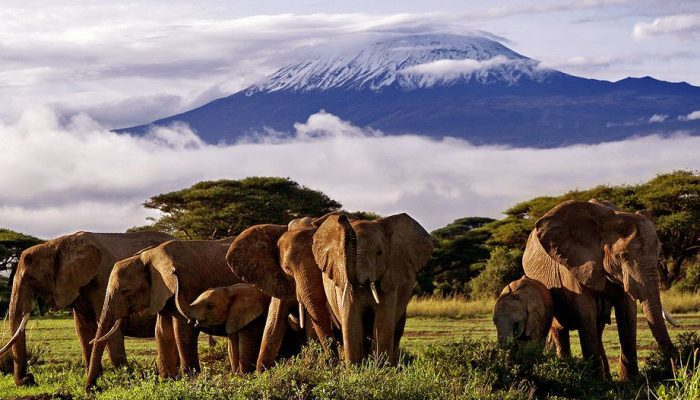
They also fill the two major rivers that flow in this region. At the same time, 90% of the precipitation does not leave the mountains (it is retained by the forest), and, having saturated the soil, most of the water (2/3) evaporates and returns to the atmosphere. Recently, the amount of precipitation has been gradually decreasing, which is one of the reasons for the decrease in snow cover.
Flora and fauna of Kilimanjaro
The climate of the highest volcano in the world is unique, because due to the fact that the mountain is very close to the equator, and winter reigns on the top of Kilimanjaro, a person, when climbing up, crosses absolutely all the climatic zones of our planet (there are seven in total), each of which is distinguished by its own animal and plant world.
In the south - up to 1 thousand m, in the north - up to 1.6 thousand m
At the foot of Kilimanjaro, Africans actively grow maize, beans, peanuts, sunflowers, rice, coffee, and corn. There are also sugar and banana plantations. The land here is abundantly covered with herbaceous vegetation, shrubs and a few low-growing trees characteristic of the savannah. You can often see monkeys, leopards, servals, and honey badgers here.
1100–1800 m
This area of the mountain is densely populated (500 people/km2). Representatives of the Chagga tribe built a network of irrigation canals here, and they grow, graze livestock, and keep apiaries.
The natives use natural resources (mainly foothill and mountain forests) very irrationally: many trees were cut down for arable land and used for fuel. Trees grow only in hollows or gorges.
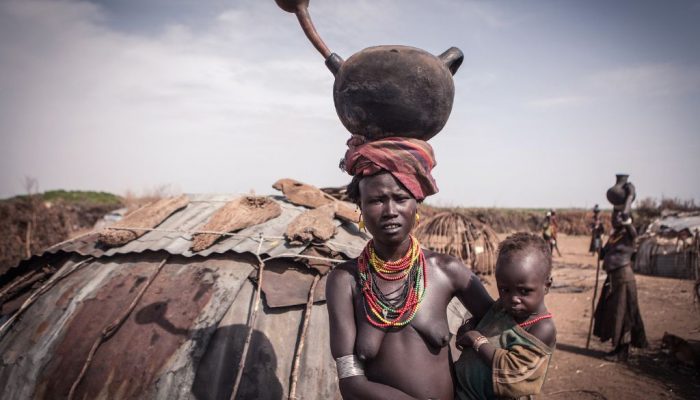
1800 m – 4000 m
Here, too, local residents actively cut down the forest for timber and fuel. There are also a lot of forest plantations - huge plantations of cypresses, eucalyptus, pine trees, and in their shade vegetables are grown, and livestock are grazed in the meadows and near reservoirs.
The soil is thin, poor, clayey. The mountain forest zone begins at this altitude, the maximum rainfall is about 2 thousand mm per year, and temperatures range from 20°C to 28°C. At an altitude exceeding 2.4 thousand meters, a thick layer of clouds often forms, which are another important and additional source of moisture.
Rainforest at an altitude of about three thousand meters gradually disappears, but alpine heather shrubs appear. The soil becomes porous, so water penetrates well through it, there is little precipitation (from 760 to 1 thousand mm) - therefore, a huge number of cereals and bulbous plants can be found here.
4000 m – 4600 m
On the slopes of the mountain at an altitude of 3 to 4 thousand meters you can often see mountain swamps and meadows covered with bright flowers. Giraffes, elephants, lions, and some species of rodents live at this altitude.
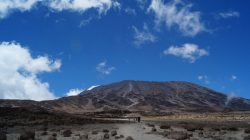

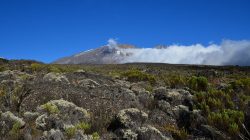
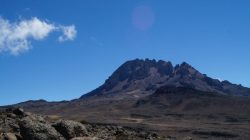
![]()
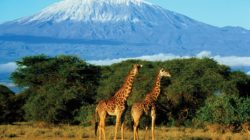

4500 – 5000 m
An arid highland desert with little precipitation (about 200 mm per year) and little vegetation. The daily temperature difference here is about 40°C. The air at this altitude is thin and there is very strong solar radiation.
From 5000 m
And even higher, at the top of Kibo, snow, cold stone and eternal ice begin, covering the top of the mountain for 11 thousand years after the ice age ended. There are several glaciers in this area, each of them has its own name and thickness (this is primarily due to the fact that precipitation falls unevenly).
Kilimanjaro Ice Cap
It is the snows of the Kibo peak that have recently attracted the attention of researchers. The fact is that they are melting - and they are doing it extremely quickly: over the last century, according to scientists, snow cover has decreased by 80%.
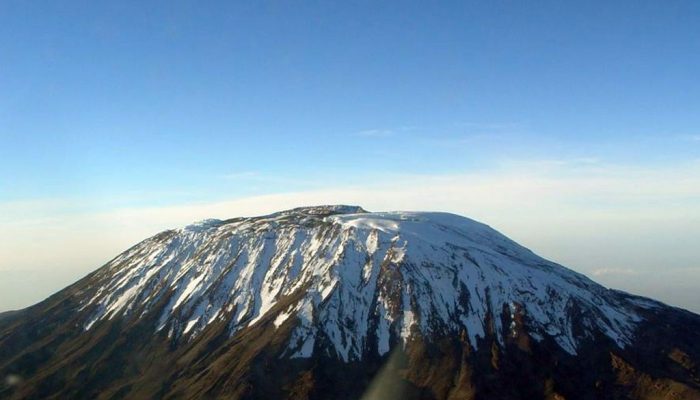
The figures they give are impressive: at the beginning of the 21st century, the area occupied by snow was 2 km², while a hundred years ago this figure was 12.1 km². In the second half of the 20th century, the thickness of the snow cover decreased by an average of 17 meters and, apparently, continues to actively melt further. Many experts predict that snow on Kilimanjaro may soon disappear completely.
It is believed that this situation was caused not so much by a change in temperature as by active deforestation, due to which the amount of water vapor that rises into the sky and falls on the top of Kibo has decreased.
Another reason for the catastrophically rapid melting of snow is the volcano itself: its dark-colored volcanic rocks absorb heat and heat the glaciers below, which is why the glaciers melt and collapse, freeing the surface from snow and thus increasing the area of the territory capable of absorbing the sun's rays.
Best time to go
Experienced tourists advise climbing the mountain from December to March, when there is no rainy season and the air temperature is optimal for humans - about 28-30 degrees. Although a seasoned climber can reach the top in less than a day, many people need adaptation to get used to the climate and avoid altitude sickness. Therefore, the trek to the top usually takes from 5 to 7 days.
Climb Kilimanjaro
The first Europeans climbed to the top of the high mountain Africa only in 1889. It is noteworthy that when the anniversary of this event was celebrated a hundred years later, the guest of honor of the holiday was precisely the guide who accompanied the white people during the ascent - at that moment he was 18 years old.
Nowadays, you can only climb Kilimanjaro from Tanzania - there are special agreements in this regard between this country and Kenya, so the Kenyans do not even have a developed infrastructure in this direction, and along the mountain there are police posts that make sure that there is no unauthorized lifts.
At the same time, the Kilimanjaro territory in Tanzania received the status of a national park and was included in the UNESCO list. Six routes of varying difficulty have been specially developed for tourists, so almost anyone can climb, despite the enormous height; for example, Bernard Gusen, being in a wheelchair, did it twice.

Another positive thing about climbing the mountain is that it can be done lightly: there is a unique service from local residents- for five dollars a day they will carry luggage to the very top, holding it on their heads.
View from the top
Despite the ease of ascent, only 40% of the number of climbers who started the climb reach the top. A magnificent landscape opens up before tourists who climb the mountain: below, under their feet, clouds are visible, and around the volcano, illuminated by the gentle rays of the bright daylight, lies a huge savannah, golden desert sands and nature untouched by people.

Kilimanjaro- the highest and potentially active stratovolcano in Africa, located in the northeast of Tanzania, the highest point of the continent (5895 m above sea level). From 1902 to 1918 it was called Kaiser Wilhelm Peak(German) Kaiser-Wilhelm-Spitze). Kilimanjaro rises above the Masai plateau, which is located at an altitude of 900 meters above sea level. There are several versions about the origin of the name. In 2003, scientists concluded that molten lava lies just 400 meters below the crater of Kibo's main peak. While no activity other than the current gas emissions is predicted, there are concerns that the volcano could collapse, leading to a major eruption similar to Mount St. Helens. Several landslides and ground shifts have already occurred on Kibo in the past. As a result of one of them, the so-called “western gap” was formed.
Kilimanjaro has no documented eruptions, but local legends speak of volcanic activity 150-200 thousand years ago. The highest point of the mountain and Africa is the Uhuru peak of the Kibo volcano, 5895 m, belonging to the “Seven Summits”. The peak was first conquered by Hans Meyer and Ludwig Purtscheller in the city. The other two peaks are also extinct volcanoes: Mawenzi (5149 m, the third highest peak in Africa after Uhuru and Mount Kenya) and Shira (3962 m).
Story
The first mention of these snow-capped mountains dates back to the 2nd century AD. e. They are indicated on Ptolemy's geographical map. But the date of discovery of Kilimanjaro by Europeans is considered to be May 11, 1848, and the discoverer is the German pastor Johannes Rebmann. In 1861, a height of 2500 m was conquered, in 1862 the mark of 4200 m was reached, in 1883, 1884 and 1887 - the mark of 5270 m; all of these ascents were accomplished by the Hungarian Count Samuel Teleki. On October 5, 1889, German traveler Hans Meyer, together with Austrian climber Ludwig Purtscheller, reached the summit for the first time. In 1996, their fellow climber from the Chaga people, Mzee Lauvo (Lawo), who was supposed to be more than 120 years old, was still alive in Marangu. Mawenzi was only conquered in 1912 by Ohler and Klute.
The book Life, Travel and Work in East Africa describes how its author, Charles New, attempted to conquer Kilimanjaro in 1861 wearing tropical shorts and a light shirt, while his 13 porters were completely naked. It is not surprising that they were unable to reach the summit, although they reached the snow line.
origin of name
The name comes from the Swahili language and supposedly means "mountain that sparkles."
It is not known exactly how the name came about Kilimanjaro, there are several theories on this matter. Many of these theories suggest that the word is broken down into Kilima(Swahili for "hill, small mountain") and Njaro, whose versions vary from the ancient Swahili word white or sparkling to the word of the Kichagga language (English) jaro, meaning caravan. The disadvantage of these theories is that they cannot explain why the diminutive is used kilima instead of what is appropriate for a mountain mlima. Another approach suggests that the name comes from a Kichagga word kilemanjaare or kilemajyaro, meaning “one who defeats a bird/leopard/caravan.” However, this theory does not explain the fact that the name Kilimanjaro itself was not used in the Kichagga language until recently.
Mountaineering
Climbing Uhuru Peak (5895 m, Kibo Volcano) is considered quite simple, but requires time for altitude acclimatization. The main routes leading to its peak (Lemosho, Machame, Umbwe, Marangu and Rongai) can be climbed by almost anyone (if there are no contraindications for health reasons) without mountaineering training or special equipment. Due to the proximity of the mountain to the equator and the altitudinal zone, when climbing, a person consistently overcomes most of the Earth’s climatic zones. According to statistics, only about 60% of all applicants reach the top. Of the popular routes, the Marangu trail has the worst success rate as it is the only route that can be used for a five-day climb, which for many is a rather difficult challenge. An even smaller number of ascents are carried out along the Western Breach route, but it is of interest only to professional climbers due to its difficulty.
Climbing the Mawenzi volcano requires mountaineering training and is currently prohibited due to the high risk to life. For the most part, this ban was made due to the influence of the media on the tourist flow to Tanzania. Provocative headlines (such as “Death on Kilimanjaro”) create a negative impression among readers about the mountain range as a whole, blurring the boundaries between professional mountaineering and trekking.
The absolute record for the fastest ascent and descent of Kilimanjaro belongs to the Swiss Karl Igloff. Karl Egloff) - 6 hours 42 minutes and 24 seconds (2014, along the Umbwe route). Previously, the ascent record was held by the Spaniard Kilian Jorne Burgada (English) Russian , which ascended and descended in 7 hours 14 minutes (net time for ascent 5 hours 23 minutes and 50 seconds), in turn, by several minutes beat the previous record (in terms of ascent speed) of Kazakhstani Andrei Puchinin in 2009 - 5 hours 24 minutes and 40 seconds along the Marangu route.
Geography
Location
Kilimanjaro rises in northeastern Tanzania to 5,891.8 meters as measured in 2008 using GPS and gravimetry, replacing the previous value of 5,895 meters obtained in 1952 by a British team. The height, which has been the subject of measurements since 1889, with results that differed by more than a hundred meters, is the largest in Africa and therefore Kilimanjaro is one of the Seven Summits. It is located near the border with Kenya, which runs along the northern and eastern slopes of the mountain. It rises in the middle of a flat savannah that surrounds the teardrop-shaped mountain at 4,800 - 5,200 meters, making it the highest isolated mountain in the world. Kilimanjaro covers an area of 388,500 hectares. The mountain with an oval-shaped volcanic cone extends 70 km from northwest to southeast and 50 kilometers from northeast to southwest and is located 340 km south of the equator. Mount Meru is located 75 kilometers to the southwest, and Mount Kenya, the second highest peak in Africa, is 300 kilometers to the north. The nearest town, Moshi, is located south of the mountain in Tanzania, and is the main starting point for climbing it. Kilimanjaro International Airport, located fifty kilometers southwest of the summit, has served the entire region and all its parks since 1971. Dodoma, the capital of Tanzania, and Dar es Salaam are respectively 380 km to the southwest and 450 km to the southeast, while Nairobi is only 200 km to the north-northwest. The Indian Ocean coast is 270 km from Mt. Administratively, Kilimanjaro is located in the Kilimanjaro region, partially covering the areas of Hai, Moshi Rural and Rombo, where the highest point is located, and most of the mountain. The volcano is fully included in Kilimanjaro National Park.
Topography
Kilimanjaro is an almost conical stratovolcano. It consists of three main peaks, which are also extinct volcanoes: Shira in the west with 3,962 meters above sea level, Kibo with 5,891.8 meters in height in the center and Mawenzi with 5,149 meters in height in the east. Kibo is crowned at the top by an elliptical caldera 2.4 km wide and 3.6 km long, surrounding a crater called Reusch Crater with a diameter of 900 meters, in the center of which stands a cone of ash 200 meters in diameter, which called Ash Pit. The main peak, located on the southern edge of the crater, is called Ugur. Other famous points of Kibo are the Inner Cone at an altitude of 5835 meters, Hans Meyer Point, Gilman's Point, Leopard Point and Johann's Gulch. Yohanas "Notch", named after the guide who accompanied the first ascent of the mountain. To the southwest of the peak, about 100,000 years ago, a great shift created the Western Breach, rising on the Barranco Valley Mawenzi, sometimes considered the third highest peak in Africa after Mount Kenya, has been heavily eroded and now has the appearance of a dam that separates from the peaks of Hans Meier, Purtscheller Peak, South Peak and Nordeckle. English: Nordecke). From their base, several chasms go in an easterly direction, in particular Great Barranco, Lesser Barranco. The Saddle is a plateau with an area of 3600 hectares between Mawenzi and Kibo. Shira, from which the Johnsell Point is separated Johnsell Point) consists of half a fractured crater, of which only the southern and western edges remain. To the northeast of it, at 6,200 hectares, the mountain has the shape of a plateau. About 250 smaller cones lie on either side of these three peaks on a northwest/southeast axis.
Hydrology
Kilimanjaro's ice cap is limited to the peak of Kibo. In 2003, it covered an area with a total area of 2 km². It consists:
- at the top:
- from the Furtwängler glacier,
- on the Northern Icefield - glaciers:
- Drygalski,
- Great Penck
- Little Penck
- Pengalski (eng. Pengalski),
- Lörtscher Notch and
- Credner
- in the West:
- Barranco Glaciers
- or Small and Big Breach (eng. Little Breach, Big Breach),
- Arrow and
- Uhlig,
- Barranco Glaciers
- on the Southern Icefield - glaciers:
- Balletto,
- Diamond
- Heim (eng. Heim),
- Kersten,
- Decken,
- Rebmann and
- Ratzel
- and finally, the Eastern Icefield.
Geographic variability in precipitation and sunshine explains the differences in size between different ice fields.
Mount Kilimanjaro's cap has been shrinking since about 1850 due to a natural decrease in rainfall of 150 mm, but this trend accelerated significantly in the 20th century. Like the current one, the rapid and almost complete melting of the glacier on Kilimanjaro occurred 4000 years ago during a long 300-year drought. Thus, the average daily temperature has increased by 3°C during the last thirty years at Lyamungu, 1230 m on the southern slope. However, temperatures remain consistently below 0°C at altitudes where glaciers are found. Georg Kaser of the University of Innsbruck and Philipp Mothe of the University of Washington have shown that the sharp shrinkage of the glacier is mainly due to a decrease in precipitation. This may be due to local changes caused by deforestation, which leads to lower vegetation density and lower atmospheric humidity. There is a pattern between the decline in ice cover and the rate of forest loss, especially during the early twentieth century and during the stabilization process. However, as evidenced by the characteristic sharp shape of the ice, the ice is sublimated by solar radiation after several wet decades in the nineteenth century. This is likely accelerated by a slight decrease in albedo in the 20th century, especially in the 1920s and 1930s. Another phenomenon that causes glaciers to shrink is the absorption of heat by dark volcanic rocks and its distribution at the base of the glaciers. They melt, become unstable and break down, increasing the surface area exposed to solar radiation.
Flows from melting ice feed the two major rivers in the area, but 90% of the precipitation is retained by the forest. The disappearance of glaciers should not directly affect the local hydrological regime, unlike deforestation and human activities resulting from the quadrupling of water withdrawals for irrigation over the past forty years. Kilimanjaro forests receive 1.6 million cubic meters of water per year, 5% of which is in the form of precipitation. Two-thirds return to the atmosphere through evaporation. The forest plays a triple role as a reservoir: it retains water in the soil, in biomass and in the air. Since 1976, rainfall has decreased by an average of twenty million cubic meters per year, which is the volume of the current cap in three years, and 25% less in the last thirty years, equivalent to the annual drinking water consumption of a million jagga 11,000 years. It is believed that this is not caused by a change in temperature, but by a reduction in the amount of snowfall. Apparently, deforestation in the last century has seriously reduced the amount of water vapor that reaches the top of Kilimanjaro and falls there in the form of snow.
